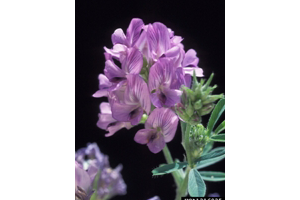Medicago sativa

Alfalfa/lucerne was one of the first forage crops to be domesticated, and is currently the most important forage crop globally. Although it was domesticated to feed animals, it is also used around the world medicinally and as a vegetable. Additionally, it is used in revegetation and restoration projects, in dyes, paints, and varnishes, and in manufacturing paper.
Photo Credit: © Keith Weller, USDA Agricultural Research Service, Bugwood.org.
Medicago sativa
Common Name: alfalfa
Plant Functional Group: Forb
Class > Order > Family: Magnoliopsida > Fabales > Fabaceae
ITIS information for
alfalfa (ITIS TSN: 183623 )
USDA PLANTS profile for alfalfa (USDA Symbol: MESA )